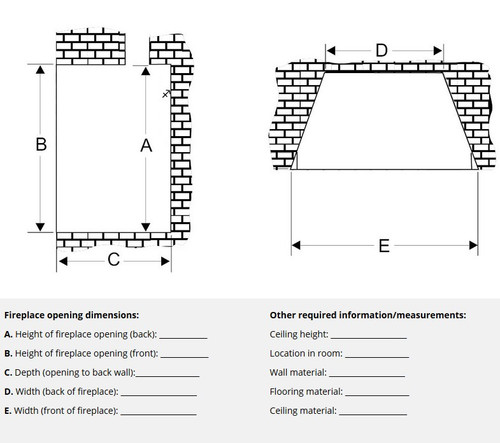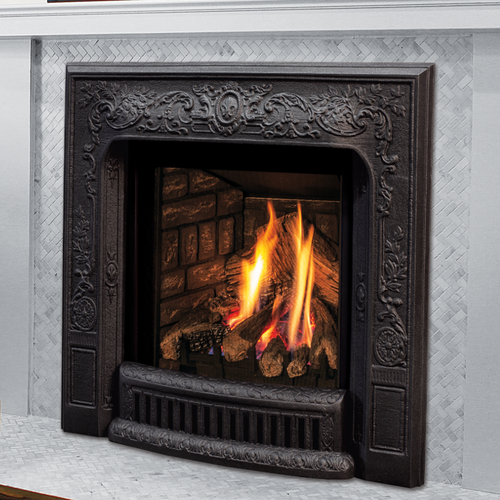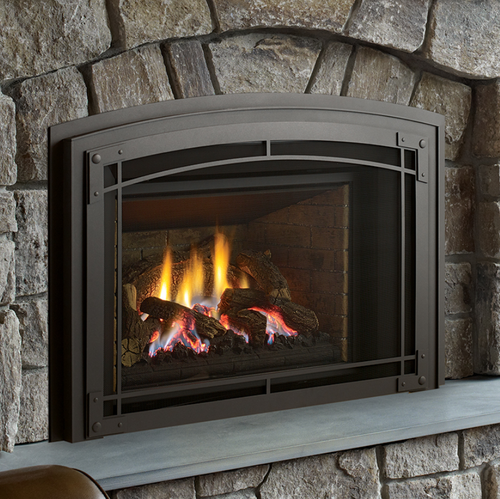Product Description
Everything You Need To Know About Purchasing a Gas Burning Fireplace Insert
Designed to fit into your existing masonry fireplace, It’s easy and affordable to upgrade your fireplace with a modern gas fireplace insert. Installing a gas fireplace insert is a quick and affordable way to update the look of a room, add value to your home and lower your monthly home heating bill. Gas fireplace inserts are installed into open masonry fireplaces to stop cold chimney draft, increase home heating efficiency and improve indoor air quality
How to get started
FAQ - Gas Burning Fireplace Inserts
Direct Vent Gas Inserts
All of our gas inserts are direct vented to keep you warmer, maintain indoor air quality and save you money, direct vent gas fireplace inserts stop cold drafts from entering your home and they prevent warmed air from escaping. Unlike traditional open flue or natural draft gas fireplaces that use air from inside your home for combustion, direct vent gas fireplace inserts use air from outside of your home. Direct vent gas fireplaces inserts are very popular due to their safety, warmth and efficiency.
B Vent Gas Inserts
For the most part this style of venting is no longer used, natural draft gas fireplace (B vent) use the natural buoyancy of warm air to evacuate combustion gases from the flue to the exterior of your home. B-vent gas inserts draw air from the area around your fireplace for combustion.
Vent Free Gas Inserts
Vent free products are not aloud above 3500 feet in altitude. Vent Free inserts don't require ventilation and allows all the heat created by the fire to stay in your home. Of course, it’s not exactly that simple. By-products are still created when burning gas in your home, including carbon dioxide, carbon monoxide, sulfur dioxide, among others. These gases get pushed into your home along with the heat, which can create a dangerous situation if not carefully monitored
Remote Control Heat
Many of our gas fireplace insert can be turned on the same way you turn on your television… with a remote! Better yet, similar to how TV’s can be programmed to record your favorite show, modern gas fireplace inserts can be programmed to turn on and off and up and down with the push of a button. remote can also operate the fan in your fireplace and modulate your flame height.
Safety Screen
All of our gas inserts include safety screens to help protect little ones from hot glass on our gas insert fireplace inserts.
Ceramic Glass
All of our gas fireplace inserts feature a ceramic glass viewing window to maximize radiant heating and durability.
Heat You Can Turn Down (and up)
Unlike your furnace, fire is beautiful. In addition to warmth, fire creates stunning ambience that we humans love to enjoy all year round. On freezing winter nights you need maximum heat, but what about cool spring days? If you want a gas fireplace insert that you can enjoy almost all year, look for one that has a broad BTU
Variable Speed Blowers
Turn your blower fan on, off, up or down the choice is yours! Fireplace blowers push heat into the far corners of the room and beyond so you can warm up fast and zone heat efficiently. Blowers with multiple speeds afford the greatest amount of comfort because they can be adjusted to move warm air slowly or quickly. All gas fireplace inserts supply radiant heat, but a fireplace fan blower provides an instant, powerful heat boost.
Arched Fireplace?
Want to change the shape of your fireplace? Additional measurements will be required if you have an arched fireplace opening, or if you want to achieve the look of an arched fireplace. Take a photo of your fireplace and send it to us before you visit and we can guide you with any additional required measurements. Contrary to popular belief, you don’t need an arched gas fireplace insert for an arched fireplace opening. Usually you can accentuate or hide a fireplace arch with a standard or custom fireplace faceplate, but sometimes masonry work is required, which is why photos and measuring is needed.
What is an IPI ignition system?
Intermittent Pilot Ignition is an electronic system, which uses an electrode to ignite the pilot gas. In turn, the pilot flame lights the main burner gas. The term Intermittent is used because the pilot burner flame is only present when the main burner is operating. When the main burner is off the pilot is also off. The IPI system ensures the pilot flame extends over the burner for immediate ignition and secondly conserves energy when the appliance is not in operation.
How much gas does the pilot light use?
A pilot light will burn 800 to 1500 BTUs/hr. Your monthly gas bill should include your exact cost per “therm” (100,000 BTUs). Based on this rate you can calculate the cost for your area to operate a pilot light. On average a pilot light consume anywhere for $12.00 to $14.00 of gas per month.





















